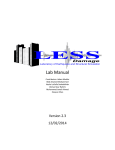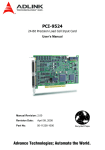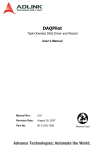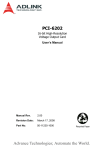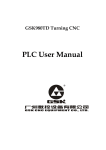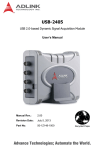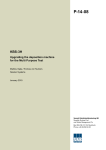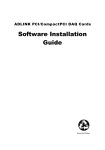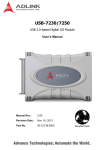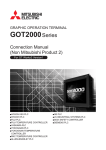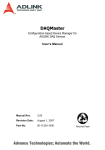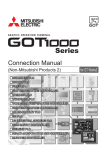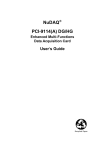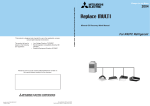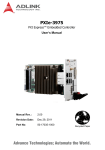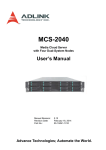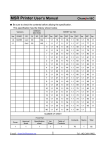Download 2 - ADLINK Technology
Transcript
Software Overview ADLINK delivers robust software support for their comprehensive line of DAQ cards in a variety of form factors: USB, PCI Express®, PCI, CompactPCI, and PXI. ADLINK offers driver for mainstream Windows and Linux Operating Systems, and provide various SDK support for third-party applications including Visual Studio, LabVIEW™ and MATLAB®. In addition, ADLINK also provides componentware for measurement and HMI, and ready-to-run Application, like Data Logger software. ADLINK Software Supporting Microsoft® Windows® Frameworks Visual Studio .NET LabVIEW™ ActiveX Control &.NET Assembly VI for LabVIEW™ MATLAB® DAQ Toolbox for MATLAB® Ready to Run Applications DAQBench DASK Low Level API D2K-DASK, PCIS-DASK, WD-DASK, UD-DASK, DSA-DASK Windows XP, and Windows 7/8 x64, x86 edition ADLINK DAQ Cards in Various Form Factor: PCI, PCI Express, CompactPCI, USB, PXI (General-purpose DAQs, Digital I/O, Analog Output, Performance DAQ, High-Speed Digital I/O, Digitizers) * National Instruments and LabVIEW are trademarks of National Instrument, Inc. * MATLAB® is a trademark of The MathWorks, Inc. 2-1 www.adlinktech.com Multiple OS Support 1 PXI/PXIe For different operating systems, we design API with the native programming logic, so users can simply install the driver without modifying the program when migrating between different operating systems. ADLINK provides drivers to support Windows 2000/XP, Windows 7/8 (x86 and x64) and Mainstream Linux distributions: Ubuntu, Fedora. And also provides legacy driver/SDK for legacy ISA-bus DAQ Cards. Windows 2000/XP Linux Windows 7/8 x64/x86 Ubuntu Fedora 2 SDK & Componentware ActiveX Controls/.NET Assembly, Express VI and Polymorphic VI for LabVIEW and DAQ Toolbox for MATLAB. For Low Level API, we also provide DASK Native Libraries for different product lines. DAQBench is the componentware for developing HMI application. DAQPilot : ADLINK Task-oriented DAQBench : 32-Bit ActiveX Controls for SDK for Windows Measurement and SCADA/HMI Modular Instruments ADLINK provide various SDK to its comprehensive line of data acquisition products. DAQPilot is a task-oriented Software Development Kit, include 3 DAQ Third-party Software Support For LabVIEW users, ADLINK provide Express VI and Polymorphic VI libraries. For MATLAB users, ADLINK provides MATLAB Data Acquisition Toolbox Adapter for all DAQ Cards. In addition, ADLINK is a Math Works Connections Program partner for long term product support. Express VI and Polymorphic VIs MATLAB® DAQ Toolbox for for LabVIEW™ ADLINK DAQ Cards 4 ADLINK provides various ready-to-run applications, like AD-Logger, a Data logger Software; DAQMaster, a configuration tool for data acquisition devices requiring no programming, and specific ready-to-use utilities for USB DAQ by U-Test and for Dynamic Signal Acquisition Modules by DSA-Utility. AD-Logger : Configuration-Based DAQMaster : Configuration-Based U-Test : Full function testing Data Logger for ADLINK DAQ Cards Device Manager for ADLINK DAQ Cards of ADLINK USB DAQ www.adlinktech.com 2-2 GPIB & Bus Expansion Ready to Run Application 8 Steps to Get ADLINK Products Ready Install the DAQ Card / Install System Manager Install the Driver for Module Configure and Test Windows Open the Box ADLINK DAQ Cards / Modules Install ADLINK Product Package Insert the ADLINK All-in-one CD Insert the ADLINK All-in-one CD PXI Platform Click ”Driver Installation” ADLINK DAQ Cards / Modules ADLINK All-in-one CD Click ”DAQMaster*” for installation to install ADLINK DASK Drivers PCIS-DASK ADLINK PCI/PCIe/cPCI Series DAQ Cards D2K-DASK ADLINK DAQ/DAQe/PXI-2000 Series Cards WD-DASK ADLINK High-Speed Digitizers UD-DASK ADLINK USB DAQ Modules DSA-DASK ADLINK Dynamic Signal Acquisition Modules Fanless Embedded Computer Industrial Computer NOTES: *Please download Windows drivers and API Library from the corresponding product page at the ADLINK website. *Linux drivers and API Library are also available. For more information, please visit http://www.adlinktech.com/MAPS/linux_daq.html *DAQMaster support for ADLINK DAQ/DAQe/PXI-2000, 6000, 8000, 91XX, 92XX Series Cards. 2-3 www.adlinktech.com 1 PXI/PXIe ADLINK provides the key concepts of data acquisition and aims to help you get started quickly. The diagram takes you through the eight steps of driver installing, system manager configuring and testing, SDK & ready-to-run applications installing of your data acquisition application. Using these eight steps will reduce your hardware set-up and software development time for your data acquisition applications! 2 Modular Instruments Ready for Install Ready-to-run Install SDK Development Application Reboot System 3 DAQ For Visual Studio .NET DASK API & DAQPilot For MATLAB For DSA Module DSA-Utility 4 DAQ-MTLB For USB DAQ U-Test For LabVIEW GPIB & Bus Expansion Reboot the System DAQPilot For DAQ AD-Logger DAQPilot Task-oriented SDK for ADLINK DAQ Cards DAQ-MTLB MATLAB ® Data Acquisition Toolbox Adapter for ADLINK DAQ Cards DSA-Utility Utility for ADLINK Dynamic Signal Acquisition Modules U-Test Utility for USB DAQ Modules AD-Logger Configuration-based Data Logger NOTE: Please download the SDK and ready-to-run applications from the corresponding product page at the ADLINK website. www.adlinktech.com 2-4 Wide Selection of Modular Instruments Overview From entry-level to high-end, data acquisition to digital input/output, ADLINK provides a diversity of modular instruments with market-leading price/performance ratio, for bigger and better measurement and automation systems. Now high-speed digitizer, switching, simultaneous data acquisition, high-density multi-function data acquisition, analog output, digital multimeter, and arbitrary waveform generator categories are all available. High-Speed Digitizers Dynamic Signal Analyzer Digitizers offer quick and precise input signal acquisition and are widely A dynamic signal analyzer provides highly accurate measurements and used in IC testing, video testing, automatic test equipment, radar and analysis widely used in audio testing, acoustic measurements, sonar testing, among others. Digitizers optimized for automated test environmental noise testing, vibration analysis, NVH measurement, take advantage of the high-throughput PXI and PXI Express buses to machine condition monitoring, and rotating machinery evaluation. lower test times, and offer picosecond-level synchronization between ADLINK’s PCI/PXI-9527 features a high resolution of 24 bits, two analog modules. ADLINK provides full spectrum modules including the inputs with sampling rates up to 432 kS/s and two analog outputs with PXIe-9848 8-CH 14-bit 100 MS/s digitizer, the PCI/PXI-98X6 Series with update rates up to 216 kS/s. The PCI/PXI-9527 offers the flexibility 4-CH 16-bit and 10/20/40 MS/s, the PCIe-9852 with 200 MS/s 14-bit needed to create a wide variety of automatic test systems with optimal 2-CH performance, and many other choices. cost-performance. Switches Arbitrary Waveform Generators Switches are widely used in automatic test equipment (ATE), process Arbitrary waveforms generate user-defined signals in automation and control systems, data acquisition systems, etc. ADLINK offers several measurement application. The TE-5201, a single channel PXI-based types of switches to meet your application requirements. ADLINK AWG, provides a high-speed waveform to stimulate signal distortion, switches include 16-CH general-purpose relays, 24-CH scanners or power line cycle dropouts, video signals, and power supply transience. multiplexers, and a 32 cross-point two-wire matrix. 2-5 www.adlinktech.com 1 Digitizer Applications PXI/PXIe For quantifying and analyzing physical energy Leveraging processing power and high-resolution display of PC – PC-based oscilloscope Defining custom measurement functions by software, such as spectrum analysis, frequency domain analysis, rise/fall time of signals, and more PCIe/PXIe-9852 Sampling Rate 200 MS/s 14-Bit 2-CH High Speed Digitizers Distributed Temperature Sensing P 2-11 PCIe/PXIe-9842 Video Signal 200 MS/s 14-Bit 1-CH High Speed Digitizers P 2-15 100 MS/s 14-Bit 8-CH High Density Digitizers P 2-9 PXI-98x6 Power Supply Unit Testing 10/20/40 MS/s 16-Bit 4-CH Digitizers Radar & LiDAR P 2-13 Modular Instruments PXIe-9848 2 Military & Education PCI/PXI-9820 P 2-16 65 MS/s 14-Bit 2-CH PCI/PXI Digitizers 20 MS/s 10/12-Bit 4-CH PCI Digitizers Power & Energy P 2-17 3 DAQ PCI-9812/9810 PXIe-9529 Sound & Vibration 24-Bit 192 kS/s 8-CH High-Resolution DSA P 2-18 PCI/PXI-9527 24-Bit 432 kS/s High-Resolution DSA 12-Bit 14-Bit 16-Bit 24-Bit P 2-19 4 Resolution GPIB & Bus Expansion Digitizers v.s. DAQs How to make the choice between a Data Acquisition (DAQ) board and a High-Speed Digitizer? Sampling Rate The difference between a digitizer and standard DAQ is the sampling rate and the bandwidth. A digitizer can extend its sampling rate from MS/s to GS/s grade, and the bandwidth can also extend from 10 MHz to GHz. Additionally, the input impedance or the module’s memory capacity can provide more options for use in different application environments. Given the features of what are referred to as high accuracy signals, only a digitizer with high sampling rate and high bandwidth can successfully accomplish the task. Sampling rate from MS/s to GS/s Bandwidth ranges from 10 MHz to GHz Input impedance : 50 Ω, 75 Ω,…high impedance Onboard memory support (512 MB, 1 GB, …) Resolution 8-Bit 14-Bit 24-Bit www.adlinktech.com 2-6 Selection Guide Digitizer Form Factor Channels Sampling Rate 40 MS/s 4-CH 20 MS/s 10 MS/s PCIe 2-CH 1-CH Onboard Memory 16-Bit 512 MB 12-Bit PCI 2-CH Input Resolution 32 k samples PXI PXIe 2-13 PCI-9812A 2-17 PCI-9812 2-17 32 k samples PCI-9810 2-17 512 MB - PCI-9816 2-13 512 MB - PCI-9820 2-16 1 GB - PCIe-9852 2-11 - - PCIe-9842 2-15 - PXI-9846 2-13 - PXI-9826 2-13 - PXI-9816 2-13 512 MB 2-CH PXI-9820 2-16 512 MB - PXIe-9848 2-9 14-Bit 512 MB 16-Bit 65 MS/s (External) 60 MS/s (Internal) 2-13 PCI-9826 16-Bit 10 MS/s 2-CH PCI-9846 10-Bit 200 MS/s 20 MS/s Page 3-CH 40 MS/s 4-CH Module Name - 128 k samples 65 MS/s (External) 60 MS/s (Internal) Digital Input 14-Bit 8-CH 100 MS/s 2-CH 200 MS/s 1 GB - PXIe-9852 2-11 1-CH 200 MS/s - - PXIe-9842 2-15 Dynamic Signal Analyzer Analog Input Form Factor Analog Input Channels Max. Sampling Rates (S/s) Analog Output AD Resolution (bits) FIFO Size (sample) Voltage Output Channels Digital IO Update Rate (S/s) DA Resolution (bits) 5K 16 216 kS/s 24 - - - - Digital IO Module Name Page PCI-9524 2-21 PCI-9527 2-19 PXI-9527 2-19 4+4 (4-ch load cell inputs PCI PXI PXIe 2-7 www.adlinktech.com & 4-ch general Up to 30 kS/s 2 purpose AD) 2 256 K 8 DI, 8 DO (Isolated) 24 432 kS/s 4096 k 8 192 kS/s - PXIe-9529 2-18 1 OS Information Products Page Software Compatibillity Windows® Linux® LabVIEW™ (Note1) (Note2) (Note3) Visual Studio.NET MATLAB® (Note5) (Note4) Software Recommendations DAQBench DAQ Master AD Logger v v v High Resolution 2-17 PCI-9812 2-17 v v v PCI/PXI-9820 2-16 v v v PCI/PXI-9816 2-13 v v v PCI/PXI-9826 2-13 v v v PCI/PXI-9846 2-13 v v v PCIe/PXIe-9842 2-15 v PXIe-9848 2-9 v PCIe/PXIe-9852 2-11 v PCI-9524 2-21 PCI/PXI-9527 2-19 PXIe-9529 2-18 PCIS-DASK PCIS-DASK/X DAQPilot WD-DASK PCIS-DASK WD-DASK/X WD-DASK DAQPilot DAQ-MTLB PCIS-DASK/X DAQPilot DSA-DASK WD-DASK DAQPilot DAQ-MTLB v v v v Others 2 DSA Modular Instruments Digitizers PCI-9810 PXI/PXIe Software Selection Guide Utility Note. 3 (1) Windows Support for Windows 2000/XP, and Windows 7/8 x64/x86 (2) Linux Support for Ubuntu 12.04.1 LTS, Fedora Core 17, and OpenSuSe 12.1 DAQ (3) Compatible with LabVIEW™ 8.0 and above (4) Compatible with Visual Studio .NET 2005/2008, DASK for API, and DAQPilot for Componentware (5) MATLAB® Data Acquisition Toolbox 2.2 (and above) compliant High Speed Arbitrary Waveform Generator & PXI Switch Modules Model Name TE-5201 Analog Output 1-CH DAC Resolution Update Rate Output Impedance Standard Waveform Arbitrary Waveform Memory PXI-7901 PXI-7921 PXI-7931 Description Generalpurpose Two-wire Multiplexer 4-groups 2x4 Two-wire Matrix No. of Channel 16 80 mVpp to 8 Vpp into Relay Type SPDT (1 Form C) DPDT (2 Form C) DPDT (2 Form C) 50 Ω load Max. Switching 3 A @ 20 VDC 2 A @ 30 VDC 2 A @ 30 VDC 220 VDC, 250 VAC 220 VDC, 125 VAC 220 VDC, 125 VAC 50 VA, 60 W 50 VA, 60 W 50 VA, 60 W 3A 2A 3A 10 µA @ 10 mVDC 10 µA @ 10 mVDC 10 µA @ 10 mVDC 150 mΩ max. 100 mΩ max. 150 mΩ max. 2-23 2-24 2-24 14-Bit 50 S/s to 100 MS/s 50 Ω Current Max. Switching Sine, Triangle, Square, Voltage Pulse, Ramp, Sinc, Max. Switching Gaussian Pulse, Power Exponential Decay/ Max. Carrying Rise Pulse,Noise, DC Current 1 M points Sample Clock FM, FSK, Ramped FSK, Modulation Sweep Page Number 2-22 Failure Rate Contact Resistance Page Number 24 (two-wire) 48 (one-wire) 32 (two-wire) www.adlinktech.com 2-8 4 GPIB & Bus Expansion Output Range Model Name PXIe-9848 8-CH 14-Bit 100 MS/s High-Speed PXI Express Digitizer Introduction The ADLINK PXIe-9848 is a 8-CH 14-bit 100 MS/s digitizer for high frequency and wide dynamic range signals with an input frequency up to 100 MHz. The 100 MHz bandwidth analog input with 50Ω impedance receives ±0.2 V or ±2 V high speed signals. With a PCI Express bus interface and ample onboard acquisition memory up to 512 MB, the PXIe-9848 easily manages simultaneous 8-CH data streaming. Equipped with high speed and high linearity 14-bit A/D converters, the PXIe-9848 is ideal for applications requiring high-speed data acquisition, such as power module testing, LIDAR testing, and video signal analysis. Highlights Features ■ ■ ■ ■ ■ ■ ■ ■ ■ ■ PXI Express specification Rev. 1.0 compliant Up to 100 MS/s sampling rate 8 simultaneously analog inputs High resolution 14-bit ADC Up to 100 MHz bandwidth for analog input 512 MB onboard storage memory Programmable input voltage range of ±0.2 V or ±2 V Scatter-Gather DMA data transfer for high speed data streaming One external digital trigger input Full auto-calibration ■OS Information • Windows XP/7/8, x64/x86 • Linux ■Flexible Use Options The PXIe-9848 provides a flexible input range from ±0.2V to ±2V, software selectable 50Ω or 1MΩ input impedance, a wide variety of triggering options, and tight synchronization capability, all maximizing convenience of use. ■High Density Simultaneous 8-CH Data Streaming Benefiting from PXIe architecture, the PXIe-9848 easily manages simultaneous 8-CH data streaming. Users can synchronize multiple PXIe-9848 digitizers to mount a test system providing up to 64 channels in a single 9-slot PXI Express chassis. ■Extra Buffering The PXIe-9848 provides built-in memory up to 512 MB for massive data storage, enabling users to extend acquisition for preset durations. ■Software Compatibility • LabVIEW, MATLAB, Visual Studio, Visual Studio.NET Equipped with ADLINK PXES-2590 PXIe chassis and PXIe-9848 modules, high density testing system with up to 64 channels can be implemented. Note: For PXES-2590 details, please refer to pages 1-13. Specifications Analog Input IO connector definition TRG IN CH0 CH1 CH2 CH3 CH4 CH5 CH6 CH7 ■ Number of channels: 8 single-ended ■ Input impedance: 50Ω or 1MΩ, software selectable ■ Input Coupling: AC or DC, software selectable ■ Input signal range: ±0.2 V or ±2 V ■ Overvoltage protection: ±5 V ■ ADC resolution: 14 bits, 1 in 16384 ■ Crosstalk: < -80 dB from DC to 1 MHz, for all input ranges ■ -3 dB bandwidth: 100MHz ■ Offset error: ±1 mV ■ Gain error: ± 0.5% ■ System noise: ■ Spectral Characteristics • Sampling rate: 100MS/s • SINAD: 65 dB • SNR: 66 dB • THD: -72 dB • ENOB: 10.58 bit • SFDR: 74 dB 2-9 www.adlinktech.com Typical values are measured using 1 MHz sine wave input at 100 MS/s with amplitude at -1dB of full scale on a ± 2V range. Acquired data lengths are in 64k points, calculated with Hanning window FFT. Digitizers 1 ■ I/O Connector: • SMB x 8 for analog inputs • SMB x 1 for external digital input ■ Dimensions (not including connectors): • 160 (W) x 100 (H) mm (6.24” x 3.9”) ■ Bus Interface: • PCI Express gen 1 x4 ■ Ambient Temperature (Operational): • 0°C to 55°C (32˚F to 131˚F) ■ Ambient Temperature (Storage): • -20°C to 80°C (-4˚F to 176˚F) ■ Relative Humidity: • 10% to 90%, non-condensing ■ Power consumption: Power Rail Standby current (mA) +3.3 V +12 V 5350 470 2 Full load (mA) 5900 500 Certifications ■ EMC/EMI: CE, FCC Class A 3 Ordering Information ■PXIe-9848 8-CH 14-Bit 100 MS/s High-Speed PXI Express Digitizer DAQ Data Storage and Transfer ■ 512 MB onboard memory, shared among the eight analog inputs (64 MB/per channel) ■ Scatter-Gather DMA data transfer General Specifications Modular Instruments Timebase ■ Sample clock source • Internal: on-board clock (oscillator) • External: PXI_CLK10 or PXIe_CLK100 • Timebase frequency: 100 MHz • Sampling rate: 100 MS/s to 1025.9 S/s • Internal timebase accuracy: < ±25 ppm PXI/PXIe Trigger ■ Trigger Source • Software • External digital trigger • Analog trigger from CH0 ~ CH7 • PXI_STAR • PXI trigger bus [0..7] • PXIe_DSTARB ■ Trigger Modes • Post-trigger • Pre-trigger • Middle trigger • Delay trigger ■ External Digital Trigger Input • Source: Front panel SMB connector • Configurable threshold: 0.8 mV to 3.3 V, default 1.67 V • Maximum input overload: -0.5 V to +5.5 V • Trigger polarity: rising or falling edge • Pulse width: 20 ns minimum ■PXIe-9848H 8-CH 14-Bit 100 MS/s High Speed PXI Express Digitizer with x15/x50 attenuator Onboard Reference ■ +2.5 V onboard reference voltage ■ < 3.0 ppm/°C reference temperature drift ■ 15 minutes recommended warm-up 4 Specifacaions Attenuation ratio Bandwidth (-3 dB) DC gain error Offset error Passband flatness Input impedance Input Capacitance Compensation Range SNR ■The 15:1 45 MHz 1% < ±2mV < ±0.4 dB 1MΩ 13.75pF 6.5 ~ 30pF 65 dB 50:1 35 MHz 1% < ±2mV < ±0.4 dB 920kΩ 15pF 6.5 ~ 30pF 66 dB attenuator is connected with the PXIe-9848 for all test conditions ■Dimensions: ■Ambient ■Relative 99.5 (W) x 94 (H) mm (3.88” x 3.67”) Temperature (Operational): 0°C to 55°C (32˚F to 131˚F) Humidity: 10% to 90%, non-condensing www.adlinktech.com 2-10 GPIB & Bus Expansion ■Attenuator dedicated fit for PXIe-9848 The attenuator is specifically designed to support the ADLINK PXIe-9848 as a signal conditioning module, providing 8 simultaneous analog inputs and 15:1 or 50:1 attenuation ratio. Input impedance, analog input connectors, over- voltage protection, and mechanical design make the attenuator board a transparent match with the PXIe-9848. The attenuator delivers the best solution to measurement range expansion in the PXI system. PCIe/PXIe-9852 2-CH 14-Bit 200 MS/s High-Speed PCI Express/PXI Express Digitizers Introduction The ADLINK PCIe/PXIe-9852 is a 2-CH 14-bit 200 MS/s digitizer for high frequency and wide dynamic range signals with an input frequency up to 90 MHz. The 90 MHz bandwidth analog input with 50Ω impedance is designed to receive ±0.2 V, ±2 V, or ±10 V high speed signals. With a PCI Express bus interface and ample onboard acquisition memory up to 1 GB, the PCIe/PXIe-9852 easily manages simultaneous 2-CH data streaming. With high speed and high linearity 14-bit A/D converters and high stable onboard reference, the PCIe/PXIe-9852 provides both high accuracy and high dynamic performance, making it ideal for applications requiring high-speed data acquisition, such as optical fiber and LIDAR testing, and video signal analysis. PCIe-9852 PXIe-9852 Highlights Data Streaming Up to 800MB/s Features ■ ■ ■ ■ ■ ■ ■ ■ ■ ■ ■ PCI Express specification Rev. 2.0 compliant (PCIe-9852) PXI Express specification Rev. 1.0 compliant (PXIe-9852) Up to 200 MS/s sampling rate 2 simultaneous analog inputs High resolution 14-bit ADC Up to 90 MHz bandwidth for analog input 1 GB onboard storage memory Programmable input voltage range of ±0.2 V, ±2 V, or ±10 V Scatter-gather DMA data transfer for high speed data streaming One external digital trigger input and one external trigger output One external clock input Full auto-calibration Supports signal averaging Based on PCI Express Gen2 technology, the PCIe/PXIe-9852 can stream data on both channels at its maximum data rate (200 MS/s), and continuously stream data to the host PC at rates up to 800 MB/s. An 8 x 500 GB driver RAID system (4TB) extends capture sessions to more than one hour. Onboard Signal Averaging Technology Every PCIe/PXIe-9852 provides onboard Signal Averaging, allowing detection of small repetitive signals in noisy environments with no CPU loading, suitable for applications requiring extraction of small signals from background noise such as optical fiber testing. Specifications Analog Input ■ Number of Channels: 2 single-ended ■ Input Coupling: AC or DC, software selectable ■ AC coupling cutoff frequency: 11 Hz ■ -3 dB Bandwidth: 90MHz ■ Input Impedance: 50Ω or 1MΩ, software selectable ■Software Compatibility ■ Input Signal Range: Range: ±0.2 V, ±2 V, or ±10 V ■ Overvoltage Protection: ■ ■ ■OS Information • Windows XP/7/8, x64/x86 • LabVIEW, MATLAB, Visual Studio, Visual Studio.NET • with 50Ω : ±10V sine wave, 7Vrms • with 1MΩ : ±10V ■ ADC Resolution: 14 bits, 1 in 16384 ■ Gain Error: ±0.65% of input ■ Offset error: ±1 mV ■ Crosstalk: < -80 dB ■ Spectral Characteristics • Input Range:±0.2 V • Sampling Rate: 200 MS/s • SINAD: 61.72 dBc • SNR: 61.77 dBc • THD: -81.42 dBc • ENOB: 9.96 bit • SFDR: 82.75 dBc ■ Spectral Characteristics • Input Range:±2 V • Sampling Rate: 200 MS/s • SINAD: 62.06 dBc • SNR: 62.11 dBc • THD: -80.97 dBc • ENOB: 10.02 bit • SFDR: 85.87 dBc 2-11 www.adlinktech.com Digitizers 1 102 20 1920 102.2 20 2010 Certifications ■ EMC/EMI: CE, FCC Class A 3 IO connector definition DAQ CLK IN TRG IN TRG OUT CH0 CH1 4 SSI Bus Cables (for multiple card synchronization) ■ACL-eSSI-2/3/4 SSI bus cable for two, three, and four devices Onboard Reference ■ +5V and +2.5V onboard reference voltage ■ < 3.0 ppm/°C reference temperature drift ■ 15 minutes recommended warmup Ordering Information ■PCIe-9852 2-CH 14-Bit 200 MS/s High-Speed PCI Express Digitizer ■PXIe-9852 2-CH 14-Bit 200 MS/s High-Speed PXI Express Digitizer www.adlinktech.com 2-12 GPIB & Bus Expansion Data Storage and Transfer ■ 1 GB onboard memory, shared among the two analog inputs ■ Scatter-Gather DMA data transfer +3.3 V +12 V +5 V 2 Modular Instruments Timebase ■ Timebase options • Internal: onboard synthesizer • External: CLK IN (front panel) ■ Sampling clock frequency • Internal: 200M Hz • External: 40M Hz ~ 200M Hz (CLK IN) • Timebase accuracy: <±25 ppm ■ External reference clock source: Front panel, SSI PCIe-9852, PXI_CLK10 or PXIe_CLK100 PXIe-9852 ■ External reference clock: 10M Hz or 100M Hz ■ External reference clock input range: 500mVpp ~ 5Vpp (AC/DC compliant) ■ External sampling clock input range: 1Vpp ~ 5Vpp (AC/DC compliant) General Specifications ■ I/O Connector • SMA x 2 for analog inputs • SMA x 1 for external trigger input • SMA x 1 for external trigger output • SMA x 1 for external clock input ■ Dimensions (not including connectors): • PCIe-9852 : 167.64 (W) x 106.68 (H) mm (6.53” x 4.16”) • PXIe-9852 : 160 (W) x 100 (H) mm (6.24” x 3.9”) ■ Bus Interface: PCI Express Gen 2 x4 ■ Ambient Temperature (Operating): • PCIe-9852 : 0°C to 50°C (32˚F to 122˚F) • PXIe-9852 : 0°C to 55°C (32˚F to 131˚F) ■ Ambient Temperature (Storage): -20°C to 80°C (-4˚F to 176˚F) ■ Relative Humidity: 10% to 90%, non-condensing ■ Power consumption: Power Rail Standby current (mA) Full load (mA) PXI/PXIe Trigger ■ Trigger Source • Software • External digital • Analog inputs • SSI (PCIe-9852) • PXI_STAR (PXIe-9852) • PXI_trigger bus [0..7] (PXIe-9852) • PXI_DSTARB (PXIe-9852) ■ Trigger Modes • Post-trigger • Pre-trigger • Middle trigger • Delay trigger ■ External Digital Trigger Input • Source: Front panel SMA connector • Compatibility: 3.3V TTL, 5V tolerance • Input high threshold: 2.0 V • Input low threshold: 0.8V • Maximum input overload: -0.5V ~ +5.5V • Trigger polarity: Rising or falling edge, software programmable • Pulse width: 20 ns minimum ■ External Digital Trigger Output • Compatibility: 5V TTL • Output high threshold: 2.4V • Output low threshold: 0.2V • Trigger polarity: Positive or negative • Pulse width: 50 ns, 100 ns, 150 ns, 200 ns, 500 ns, 1 μs, 2 μs, 7.5 μs, and 10 μs • Driving capacity: Capable of driving 50Ω load PCI/PXI-9816/9826/9846 4-CH 16-Bit 10/20/40 MS/s Digitizers with 512 MB Memory Introduction PCI-9816/9826/9846 The ADLINK PCI/PXI-9816/9826/9846 are 10 MS/s, 20 MS/s, 40 MS/s sampling 16-bit 4-CH digitizers designed for digitizing high frequency and wide dynamic range signals with an input frequency up to 20 MHz. The analog input range can be programmed via software to ±1 V / ±0.2 V or ±5 V / ±1 V, based on the model. With a deep onboard acquisition memory up to 512 MB, the PXI/PCI-9816/9826/9846 are not limited by the data transfer rate of the PCI bus to enable the recording of waveforms for extended periods of time. The PXI/PCI-9816/9826/9846 are equipped with four high linearity 16-bit A/D converters ideal for demanding applications with a high dynamic range such as radar, ultrasound, and software-defined radio. Specifications PXI-9816/9826/9846 Features ■ PXI specifications Rev.2.2 compliant (PXI-98x6) Supports 5 V and 3.3 V PCI signals ■ Supports the 32-bit /66 MHz PCI interface ■ 4 channels of simultaneous single-ended analog input ■ 16-bit high resolution A/D converter ■ Up to 10 MS/s, 20 MS/s, and 40 MS/s per channel ■ 512 MB on-board memory for data storage ■ Software selectable 50 Ω or 1 MΩ input impedance ■Programmable input voltage range: ±0.2 V / ±1 V or ±1 V / ±5 V ■5.1 MHz, 9.6 MHz, and 20 MHz analog input bandwidth for the PCI/PXI-9816, PCI/PXI-9826 and PCI/PXI-9846, respectively ■ Multiple module synchronization via the PXI trigger bus or SSI (System Synchronization Interface) ■ Supports scatter-gather DMA transfer ■ 89 dBc SFDR, 79 dBc SINAD and 12.9-bit ENOB (PXI-9816) ■ Fully auto-calibration ■ Analog Input ■ Number of channels: 4 single-ended channels ■ Input impedance: 50 Ω or 1 MΩ, software selectable ■ Input coupling: DC ■ Input range: (±0.2 V, ±1 V ) or (±1 V, ±5 V), depends on model type ■ ADC resolution: 16 bits, 1 in 65536 ■ Crosstalk: <-80 dB from DC to 1 MHz, for all input ranges ■ System noise, unit in LSBRMS: ■ ■ • Windows XP/7/8, x64/x86 • LabVIEW, MATLAB, Visual Studio, Visual Studio.NET ■Software Recommendations PXI-9826D 6.0 4.0 PXI-9846D 8.0 5.0 PXI-9846W 15.0 7.0 Input Range ±1 V ±5 V PCI-9816H 5.0 3.0 PCI-9826H 6.0 4.0 PCI-9846H 8.0 5.0 PXI-9846H 8.0 5.0 Offset error: ■ • AD-Logger, DAQBench PXI-9816D PXI-9826D PXI-9846D/PCI-9846D @ 50 Ω and 1 MΩ input impedance ±0.2 V, ±1 V 5.1 MHz Input Range PCI-9816H ±1 V, ±5 V 5.1 MHz ±1 V, ±5 V Spectral Characteristics • Model: PXI-9816D/512 • Input Range: ±0.2 V • Sampling Rate: 10 MS/s • SINAD: 76.56 dBc • SNR: 76.59 dBc • THD: -95.91 dBc • ENOB: 12.42 bit • SFDR: 99.73 dBc 2-13 www.adlinktech.com PXI-9816D/9826D/9846D/9846W, PCI-9846D ±0.1% ±0.05% PXI-9846H, PCI-9816H/9826H/9846H ±0.1% ±0.06% -3dB Bandwidth, typical: Input Range ■ PXI-9816D/9826D/9846D/9846W, PCI-9846D ±0.2 mV PXI-9846H, PCI-9816H/9826H/9846H ±0.3 mV Gain error: Input Range ±0.2 V ±1 V Input Range ±1 V ±5 V ■Software Compatibility PXI-9816D 5.0 3.0 Model Name Offset error Model Name Offset error ■OS Information Input Range ±0.2 V ±1 V PXI-9846DW 80 MHz (±1 V) 55 MHz (±0.2 V) PCI-9826H PXI-9846H/PCI-9846H --@ 50 Ω input impedance 9.6 MHz 20 MHz --@ 1 MΩ input impedance 90 KHz --9.6 MHz 20 MHz PCI-9846D 8.0 5.0 Digitizers 1 -20 • Sampling Rate: 10 MS/s • THD: -88.61 dBc • ENOB: 12.96 bit • SFDR: 89.08 dBc -40 Magnitude (dB) • SNR: 80.19 dBc -60 CH2 CH3 -80 -100 -120 0 1 2 3 4 Frequency (Hz) 5 6 x 10 ■ Typical values are measured using 1 MHz sine wave input at 10 MS/s with amplitude at -1dB at full scale on a ±1 V and ±0.2 V range using the PXI-9816. Acquired data lengths are in 64 K point, calculated with Hanning window FFT. Note that these dynamic parameters may vary from one module to another, with different ■ input signal frequencies and signal amplitudes selected. ■ For detailed dynamic test results of other modules, please refer to the user manual or visit the ADLINK website. Timebase Dedicated External Clock Input From Panel ■ Connector type: SMB Clock type: sine wave or square wave ■ Input impedance: 50 Ω ■ Input coupling: AC ■ Input range: 1 Vp-p to 2 Vp-p ■ Overvoltage protection: 2.5 Vp-p ■ Triggering Data Storage and Transfer ■ On-board memory: 512 MB, shared among the four AI channels ■ Data transfer: scatter-gather DMA On-board Reference ■ On-board reference voltage: +5 V Temperature drift: < 3 ppm/°C ■ Recommended warm-up time: 15 minutes ■ General Specifications ■ I/O Connector • BNC X4 for analog inputs • SMB X2 for external digital trigger and external timebase input ■ Dimensions (not including connectors) • PCI-98x6: 167.6 mm (W) x 107 mm (H) (6.53" x 4.17") • PXI-98x6: 160 mm (W) x 100 mm (H) (6.24" x 3.9") PCI Bus Interface • PCI signaling: support 3.3 V and 5 V signaling • PCI interface: 32-bit, 66 MHz ■ Ambient temperature (Operational): • 0°C to 55°C (32˚F to 131˚F) (PXI version) • 0˚C to 50˚C (32˚F to 122˚F) (PCI version) ■ Ambient temperature (Storage): -20˚C to 80˚C (-4˚F to 176˚F) ■ Relative humidity: 10% to 90% non-condensing ■ Power Requirement, typical: Power Rails 3.3 V 5V 12 V PXI/PCI-9816 0.8 A 1.4 A 0.3 A PXI/PCI-9826 0.8 A 1.5 A 0.3 A 2 PXI/PCI-9846 0.8 A 2.0 A 0.3 A Certifications ■ EMC/EMI: CE, FCC Class A 3 Multi-Module Synchronization ■ For PXI version of digitizer modules, they can be synchronized through PXI trigger bus, PXI Star and PXI 10 MHz. ■ For PCI version of digitizer modules, they can be synchronized through a dedicate interface, SSI (System Synchronized Interface). SSI bus cable for multiple module synchronization Cable Accessories ■ ■ SMB-SMB-1M 1 meter SMB to SMB cable ■ACL-SSI-3 SMB-BNC-1M 1 meter SMB to BNC cable ■ ACL-SSI-2 SSI Bus cable for 2 devices ■ACL-SSI-4 SSI Bus cable for 3 devices SSI Bus cable for 4 devices Ordering Information Model Name PCI-9816H/512 PCI-9826H/512 PCI-9846H/512 PCI-9846D/512 PXI-9816D/512 PXI-9816H/512 PXI-9826D/512 PXI-9846D/512 PXI-9846DW/512 PXI-9846H/512 Sampling Rate 10 MS/s 20 MS/s 40 MS/s 40 MS/s 10 MS/s 10 MS/s 20 MS/s 40 MS/s 40 MS/s 40 MS/s Input Range ±5 V, ±1 V ±5 V, ±1 V ±5 V, ±1 V ±1 V, ±0.2 V ±-1 V, ±0.2 V ±5 V, ±1 V ±1 V, ±0.2 V ±1 V, ±0.2 V ±1 V, ±0.2 V ±5 V, ±1 V Max. -3dB Bandwidth 5.1 MHz 9.6 MHz 20 MHz 20 MHz 5.1 MHz 5.1 MHz 9.6 MHz 20 MHz 80 MHz 20 MHz Note: For special features or specifications, such as higher input range or higher bandwidth options, please contact ADLINK for more details. www.adlinktech.com 2-14 4 GPIB & Bus Expansion ■ Trigger sources: • software • TRG IO (front panel SMB connector) • Analog trigger from CH0 - CH3 • PXI Star (PXI version) • PXI Trigger Bus[0..7] (PXI version) • SSI (PCI version) ■ Trigger modes: Pre-trigger, post-trigger, middle-trigger, delay-trigger PCI-9816/9826/9846 DAQ ■ Sample clock sources · Internal: on-board oscillator · External: CLK IN (front panel SMB connector), PXI Trigger Bus[0..7], PXI 10 MHz, PXI Star, SSI Bus ■ Timebase frequency range · PCI/PXI-9816: 1 MHz - 10 MHz · PCI/PXI-9826: 1 MHz - 20 MHz · PCI/PXI-9846: 1 MHz - 40 MHz PXI-9816/9826/9846 ■ Modular Instruments PXI/PXIe • Input Range: ±1 V • SINAD: 79.80 dBc CLK IN TRG IO CH0 CH1 0 • Model: PXI-9816D/512 Digitizers PCIe/PXIe-9842 1-CH 14-Bit 200 MS/s High-Speed PCI Express /PXI Express Digitizers Introduction The ADLINK PCIe/PXIe-9842 is a 1-CH 14-bit 200 MS/s digitizer designed for applications such as LIDAR testing, optical fiber testing, and radar signal acquisition. The 100 MHz bandwidth analog input with 50 ohm impedance is designed to receive ±1 V high speed signal. With this simplified front-end design and high stable onboard reference, the PCIe/PXIe-9842 not only provides high accuracy measurement results but also delivers high dynamic performance. PCIe-9842 For applications that require data to be acquired and transferred in real time, the PCIe/PXIe-9842 utilizes the PCI Express x4 bus as its interface. When signals are converted from analog to digital data, data transfer to host system memory is continuous, enabled by the PCI Express’ increased bandwidth. PXIe-9842 Features ■ PXI Express specification Rev. 1.0 compliant (PXIe-9842) ■ Up to 200 MS/s sampling rate ■ High resolution 14-bit ADC ■ ±1 V Input range with 50 Ω input impedance and DC couple ■ Up to 100 MHz bandwidth for analog input ■ High speed PCI Express Gen 1 x4 bus interface ■ Scatter-Gather DMA data transfer for high speed data streaming ■ One external digital trigger input ■ One digital trigger output to stimulate external instruments ■ Full auto-calibration ■OS Information • Windows XP/7/8, x64/x86 ■Software Compatibility • LabVIEW, MATLAB, Visual Studio, Visual Studio.NET Specifications Analog Input ■ Number of Channels: One single-ended channel Input Impedance: 50 Ω ± 2% ■ Input Coupling: DC ■ Input Signal Range: ±1.0 V ■ Overvoltage Protection: ±5 V ■ ADC Resolution: 14 bits, 1 in 16384 ■ Offset Error: ±1 mV ■ Gain Error: ±0.5% of input ■ -3dB Bandwidth: 100 MHz ■ Timebase ■ Sample Clock Source: onboard oscillator ■ Timebase Frequency: 200 MHz Auto Calibration ■ Reference Voltage: +5.000 V ■ Reference Temperature drift: < 5.0 ppm/℃ ■ Recommended warm-up time: 15 minutes 2-15 www.adlinktech.com Trigger ■ Trigger Source • Software • External digital • PXI STAR (PXIe version) • PXI trigger bus [0..7] (PXIe version) ■ Trigger Mode • Post-Trigger ■ External Digital Trigger Input • Compatibility: 3.3 V TTL • Trigger condition: Rising edge or falling edge, software programmable • Minimum pulse width: 20 ns ■ Digital Trigger Output • Compatibility: 3.3 V TTL • Trigger Condition: Positive or negative, software programmable General Specifications ■ Ambient temperature (Operational): 0°C to 55°C (32˚F to 122˚F) ■ Ambient temperature (Storage): -20˚C to 80˚C (-4˚F to 176˚F) ■ Relative humidity: 10% to 90% non-condensing ■ Physical • Dimensions (not including connectors) - PCIe-9842: 175 mm (W) x 107 mm (H) (6.82" x 4.17") - PXIe-9842: 160 mm (W) x 100 mm (H) (6.24" x 3.9") ■ IO Connector • SMA x 1 for analog input • SMA x 2 for external trigger input and trigger output ■ Bus Interface • PCI Express Gen 1 x4 Certifications ■ EMC/EMI: CE, FCC Class A Ordering Information ■PCIe-9842 1-CH 14-Bit 200 MS/s High-Speed PCI Express Digitizer ■PXIe-9842 1-CH 14-Bit 200 MS/s High-Speed PXI Express Digitizer Digitizers PCI/PXI-9820 2-CH 14-Bit 65 MS/s PCI/PXI Digitizers with SDRAM 1 PXI/PXIe Introduction ADLINK’s PCI/PXI-9820 is a 65 MS/s, high-resolution PXI digitizer with deep SODIMM SDRAM memory. The device features flexible input configurations, including programmable input ranges and user-configurable input impedance. With the deep onboard acquisition memory, the PCI-9820/PXI-9820 is not limited by the 132 MB/s bandwidth of PCI bus and can record the waveform for a long period of time. The PCI-9820/PXI-9820 is ideal for high-speed waveform capturing, such as radar and ultrasound applications, as well as software radio applications, or those signal digitizing applications which need deep memory for data storage. PCI-9820 Specifications Features ■ ■ ■ ■ ■ ■ ■ ■ ■ ■ ■ ■ ■ ■ 14-bit A/D resolution Up to 60 MS/s (with internal timebase) & 65 MS/s (with external timebase) sampling rate per channel Up to 130 MS/s sampling rate in "ping pong" mode 2-CH single-ended bipolar inputs >30 MHz -3 dB bandwidth Up to 512 MB onboard SODIMM SDRAM Programmable ranges of ±1 V and ±5 V User-configurable input impedance of 50 Ω or high input impedance Scatter-gather DMA Analog and digital triggering 2-CH synchronous digital inputs (PXI-9820) Fully auto calibration Multiple modules synchronization capability ■OS Information • Windows XP/7/8, x64/x86 ■ Input Impedance (soldering selectable): 50 Ω, 1.5 MΩ Crosstalk: < -80 dB, DC to 1 MHz ■ Total harmonic distortion (THD): -75 dB ■ Signal-to-Noise ratio (SNR) ■ Range SNR ±5V 66 dB 62 dB ±1V ■ ■ Spurious-free dynamic range (SFDR): 75 dB Data transfer: bus-mastering DMA with scatter-gather Auto Calibration ■ Onboard reference: +5 V ■ Onboard reference temperature drift: 2 ppm/˚C Stability: 6 ppm/1000 Hrs • LabVIEW, MATLAB, Visual Studio, Visual Studio.NET External Timebase Input • AD-Logger, DAQBench CLK IN CLK IN TRG IO SDI0 CH0 CH1 Current Power Rail 5V PXI-9820 PCI-9820 900 mA typical 895 mA 12 V 305 mA typical 295 mA 3.3 V 500 mA typical (with 512 MB SDRAM) 430 mA (with 512 MB SDRAM) PCI-9820: direct external timebase input PXI-9820: 10 MHz input for PLL or direct external timebase input ■ Connector: SMB ■ Impedance: 50 Ω ■ Coupling: AC ■ Input amplitude: 1 Vpp to 2 Vpp TRG IO ■ Overvoltage protection: 2.5 Vpp SDI1 ■ Frequency range: 500 kHz - 65 MHz CH0 Certifications ■ EMC/EMI: CE, FCC Class A Cable Accessories Cable Description PXI-9820 PCI-9820 SMB-SMB-1M SMB-BNC-1M ACL-SSI-2 ACL-SSI-3 ACL-SSI-4 1-meter SMB to SMB cable 1-meter SMB to BNC cable SSI Bus cable for 2 devices SSI Bus cable for 3 devices SSI Bus cable for 4 devices √ √ √ √ - √ - √ - √ Ordering Information ■PCI-9820D 2-CH 14-Bit 65 MS/s Digitizer Triggering CH1 3 ■ Dimensions (not including connectors) PCI-9820: 175 mm x 107 mm (6.82” x 4.17”) PXI-9820: 160 mm x 100 mm (6.24” x 3.9”) ■ ■Software Recommendations ± 14 V ±5V Analog Triggering ■ Modes: pre-trigger, post-trigger, middle-trigger, delay-trigger ■ Sources: CH0 and CH1 ■ Coupling: DC Digital triggering ■ Modes: pre-trigger, post-trigger, middle-trigger, delay-trigger ■ Source: external digital trigger from SMB ■ Compatibility: 5 V/TTL www.adlinktech.com 2-16 4 GPIB & Bus Expansion Overvoltage Protection ±1V ■ ■Software Compatibility Range ±5V General Specifications ■ I/O connector · BNC x 2 for analog inputs · SMB x 4 for external digital trigger, external time base, and synchronous digital inputs ■ Operating temperature: 0˚C to 50˚C (32˚F to 122˚F) ■ Storage temperature: -20˚C to 80˚C (-4˚F to 176˚F) ■ Relative humidity: 10% to 90%, non-condensing ■ Power requirements 2 DAQ ■ Supports a 32-bit 3.3 V or 5 V PCI bus PXI specifications Rev.2.2 compliant (PXI-9820) Synchronous Digital Input (For PXI-9820 Only) ■ Number of channels: 2 ■ Compatibility: 5 V/TTL ■ Data transer: bus-mastering DMA with scatter/gather Modular Instruments PXI-9820 Analog Input ■ Number of channels: 2 simultaneous-sampled single-ended ■ Resolution: 14 bits ■ Maximum sampling rate · 65 MS/s for 2 inputs · 130 MS/s for Ping-Pong mode using external timebase ■ Onboard sample memory · 512 MB ■ Bandwidth (-3 dB): 30 MHz minimum ■ Input signal ranges: (software programmable) ±5 V, ±1 V ■ Input Coupling: DC ■ Overvoltage protection Digitizers PCI-9812/9812A/9810 4-CH 10/12-Bit 20 MS/s Simultaneous-Sampling Analog Input Cards Introduction ADLINK’s PCI-9812, PCI-9810 and PCI-9812A are 4-CH, 10 or 12-bit, 20 MS/s simultaneous-sampling analog input cards. The high-speed analog input channels are single-ended, with hardware programmable input ranges of ±1 V, ±5 V and input impedances of 50 Ω, 1.25 kΩ and 15 MΩ. The onboard 32 k-sample A/D FIFO can buffer so data throughput is less than 100 Mbytes/s, the FIFO performs as the temporary A/D sample buffer, and as a rule of thumb, no data loss will occur. When four channels operate at 20 MS/s simultaneously, each sample generates two bytes, resulting in 160 Mbyes/s (4 channels * 20 M * 2 bytes) throughput, which exceeds the peak 132 Mbyte/s bandwidth of PCI bus. To avoid data loss, the 32 k-sample FIFO is the limitation of sample count. For applications requiring a larger number of samples at full sampling rate, the PCI-9812A features 128 k sample A/D FIFO for storage. In addition to the onboard 40 MHz time base, users are able to supply the external time base in either sine wave or digital forms. The PCI-9810 and PCI-9812 also feature external digital trigger and programmable analog trigger, thus the conversion start point of multiple cards can be synchronized to external events. The trigger modes include software-trigger, pre-trigger, post-trigger, middle-trigger and delay trigger, further expands the capabilities of these high-speed devices. ADLINK’s PCI-9812, PCI-9810 and 9812A deliver cost-effective and reliable data acquisition capabilities and are ideal for vibration testing, image digitizing, ultrasonic measurement, biomedical research, ATE and other high-end industrial, scientific, and military applications. Features ■ Supports a 32-bit 3.3 V or 5 V PCI bus ■ 12-bit A/D resolution (PCI-9812 and PCI-9812A) ■ 10-bit A/D resolution (PCI-9810) ■ Up to 20 MS/s simultaneous-sampling rate ■ >17 MHz -3 dB bandwidth ■ 4-CH single-ended inputs ■ Bipolar analog input ranges ■ User-selectable input impedance of 50 Ω or high-input impedance ■ Onboard 32 k-sample A/D FIFO (PCI-9810 and PCI-9812) ■ Onboard 128 k-sample A/D FIFO (PCI-9812A) ■ Analog and digital triggering ■ External clock input for customized conversion rate ■ Bus-mastering DMA for analog inputs ■ 3-CH TTL digital inputs ■ Compact, half-size PCB ■OS Information • Windows XP/7/8, x64/x86 ■Software Compatibility • LabVIEW, MATLAB, Visual Studio, Visual Studio.NET ■Software Recommendations • AD-Logger, DAQBench Specifications Analog Input ■ Number of channels: 4 single-ended Resolution · 12-bit (PCI-9812 and PCI-9812A) · 10-bit (PCI-9810) ■ Maximum sampling rate: 20 MS/s ■ Input signal ranges, impedance and overvoltage protection Input RangeModel ±1 V ±5 V Overvoltage protection 50 Ω 15 MΩ 50 Ω 1.25 kΩ ±2 V ±10 V ■ Accuracy: ±1.5% typical ■ DNL: ±0.4 LSB typical, ±1.0 LSB maximum ■ INL: ±1.9 LSB typical ■ Input coupling: DC ■ Trigger sources: software, analog and digital trigger (5 V/TTL compatible) ■ Trigger modes: software-trigger, pre-trigger, post-trigger, middle-trigger & delay trigger ■ FIFO buffer size · 32 k samples (PCI-9810 & PCI-9812) · 128 k samples (PCI-9812A) ■ Data transfers: bus-mastering DMA Triggering ■ Analog Trigger · Modes: pre-trigger, post-trigger, middle-trigger, delay-trigger · Source: CH0, CH1, CH2 and CH3 · Slope: rising/falling · Coupling: DC · Trigger sensitivity: 256 steps in full-scale voltage range ■ Digital Triggering · Modes: pre-trigger, post-trigger, middle-trigger, delay-trigger · Source: external digital trigger · Slope: rising edge · Compatibility: 5 V/TTL · Minimum pulse width: 25 ns 2-17 www.adlinktech.com Input Impedance External Sine Wave Clock ■ Input coupling: AC ■ Input impedance: 50 Ω ■ Input frequency: 300 kHz to 40 MHz ■ Input range: 1.0 to 2.0 Vpp ■ Overvoltage protection: 2.5 Vpp External Digital Clock ■ Input coupling: DC ■ Input impedance: 50 Ω ■ Compatibility: 5 V/TTL ■ Input frequency: 20 kHz to 40 MHz ■ Overvoltage protection: diode clamping, -0.3 V to +5.3 V Digital Input ■ Number of channels: 3 ■ Compatibility: 5 V/TTL with 10 KΩ pull down resistors ■ Overvoltage protection: Diode clamping, -0.3 V to +5.3 V ■ Data transfers: bus-mastering DMA with A/D samples General Specifications ■ I/O connector · BNC x 5 · 10-pin ribbon male ■ Operating temperature: 0˚C to 40˚C (32˚F to 104˚F) ■ Storage temperature: -20˚C to 70˚C (-4˚F to 158˚F) ■ Relative humidity: 10% to 90%, non-condensing ■ Power requirements Device PCI-9812 PCI-9812A PCI-9810 +5 V 1.4 A typical 1 A typical ■ Dimensions (not including connectors) 173 mm x 108 mm (6.74” x 4.21”) Ordering Information ■PCI-9810 4-CH 10-Bit 20 MS/s Simultaneous-Sampling Analog Input Card with 32 k-Sample A/D FIFO ■PCI-9812 4-CH 12-Bit 20 MS/s Simultaneous-Sampling Analog Input Card with 32 k-Sample A/D FIFO ■PCI-9812A 4-CH 12-Bit 20 MS/s Simultaneous-Sampling Analog Input Card with 128 k-Sample A/D FIFO High-Resolution Modules PXIe-9529 8-CH 24-Bit High-Resolution Dynamic Signal Acquisition Module 1 The ADLINK PXIe-9529 is a high-performance, high density, 8-CH analog input dynamic signal acquisition module. The PXIe-9529 features eight 24-bit simultaneously sampling analog input channels. The 24-bit sigma-delta ADC provides a sampling rate of 192 kS/s at high resolution, making it ideal for higher dynamic range signal measurement. All channels are sampled simultaneously and accept input range up to ±10V, and the analog inputs support software-selectable AC or DC coupling and 4 mA bias current for integrated electronic piezoelectric (IEPE) sensors. The module is especially designed to meet the requirements of vibration analysis and audio testing. Specifications Number of simultaneously sampled channels: 8 · PXI trigger bus [0..7] ■ Input configuration: Differential or pseudo-differential ■ Input impedance: · Post-trigger Differential Pseudodifferential Configuration Configuration Features Input Impedance ■ Between positive input and system ground 1 MΩ 1 MΩ Between negative input and system ground 1 MΩ 50 Ω • Windows XP/7/8, x64/x86 ■ ■ ■ ADC resolution: 24-bit ■ ADC type: Delta-sigma Trigger Modes · Delay trigger ■ External Digital Trigger Input: · 5 V TTL compatibility · Trigger polarity: rising or falling edge · Pulse width: 20 ns minimum Input coupling: AC or DC, software selectable AC coupling cutoff frequency: 0.5 Hz Timebase ■ Onboard oscillator sample clock source ■ 80 MHz timebase frequency Data Storage and Transfer ■ 512 MB onboard memory, shared among the eight analog inputs ■ FIFO buffer size: 1,024 samples dedicated for per channel ■ Scatter-Gather DMA data transfer ■ Sampling rate: 192 kS/s maximum, Onboard Reference ■Software Compatibility 8 kS/s to 54 kS/s in 192 µS/s increments, 54 kS/s to 108 kS/s in 576 µS/s increments, ■ +5.000 V onboard reference voltage 108 kS/s to 192 kS/s in 768 µS/s increments ■ < 5.0 ppm/°C reference temperature drift ■ 15 minutes recommended warmup • LabVIEW, MATLAB, Visual Studio, Visual Studio.NET ■Software Recommendations • DSA Utility ■ Input signal range: ± 10V, or ± 1V ■ Integrated Electronic Piezoelectric (IEPE): · Current: 4 mA for each channel · IEPE compliance: 24 V ■ Overvoltage protection · Differential : ± 42.4V ■PXIe-9529 8-CH 24-Bit High-Resolution Dynamic Signal Acquisition Module for PXIe bus · Pseudo-differential : ■PCIe-9529 (call for availability) 8-CH 24-Bit High-Resolution Dynamic Signal Acquisition Module for PCIe bus ■ Offset error: ± 2 mV max ■ Gain error: ± 0.5% of FSR ■ Crosstalk: < -100 dB ■ THD: < -104 dB - Positive terminal : ± 42.4V - Negative terminal : Not protected, rated at ± 2.5V Trigger ■ Trigger Sources General Specifications ■ I/O Connector: · SMB x 8 for analog inputs · SMB x 1 for external digital input ■ Dimensions (not including connectors) · 160 (W) x 100 (H) mm (6.24” x 3.9”) ■ Bus Interface: · PCI Express Gen 1 x4 ■ Ambient Temperature (Operational): · 0°C to 55°C (32˚F to 131˚F) ■ Ambient Temperature (Storage): · -20°C to 80°C (-4˚F to 176˚F) ■ Relative Humidity: · 10% to 90%, non-condensing · Software trigger · Analog trigger · External digital trigger Certifications ■ EMC/EMI: CE, FCC Class A www.adlinktech.com 2-18 4 GPIB & Bus Expansion Ordering Information 3 DAQ ■OS Information ■ Modular Instruments ■ PXI Express specification Rev. 1.0 compliant ■ 24-Bit Sigma-Delta ADC ■ 8 simultaneous sampling analog input ■ 192 kS/s maximum sampling rate ■ AC or DC input coupling, software selectable ■ One external digital trigger input ■ Support IEPE output on each analog input, software configurable ■ Full auto-calibration 2 · PXI STAR trigger Analog Input PXI/PXIe Introduction PCI/PXI-9527 24-Bit High-Resolution Dynamic Signal Acquisition and Generation Modules Introduction The PCI/PXI-9527 is a high-performance, 2-CH analog input and 2-CH analog output dynamic signal acquisition module. This module is specifically designed for audio testing, acoustic measurement, and vibration analysis applications. The ADLINK PCI/PXI-9527 features two 24-bit simultaneous sampling analog input channels. The 24-bit sigma-delta ADC provides a sampling rate up to 432 kS/s at high resolutions, making it ideal for higher bandwidth dynamic signal measurements. The sampling rate can be adjusted by setting the module DDS clock source to an appropriate frequency. All channels are sampled simultaneously and accept an input range from ±40 V to ±0.316 V. The PCI/PXI-9527 analog input supports software selectable AC or DC coupling and 4 mA bias current for integrated electronic piezoelectric (IEPE) sensors. PCI-9527 PXI-9527 Features ■ The ADLINK PCI/PXI-9527 also has two channels of 24-bit resolution, high fidelity analog output. The outputs occur simultaneously at software programmable rates up to 216 kS/s. A software programmable output range of ±0.1 V, ±1 V, and ±10 V is available on the output channels. ■Dynamic Signal Assistant PXI specifications Rev. 2.2 compliant (PXI-9527) ■ 24-bit Sigma-Delta ADC and DAC ADLINK’s Dynamic Signal Assistant is a ready-to-run software utility designed for dynamic signal acquisition ■ 2-CH simultaneous sampling analog input modules, such as the PCI/PXI-9527. This software ■ 2-CH simultaneous updated analog output provides a windows-based configuration interface ■ 432 KS/s maximum sampling rate with software for setting parameters, in addition to a real-time programmable rate visualized data display on the screen. An instrument- ■ Programmable input range: ±40 V, ±10 V, ±3.16 V, ±1 V, like user interface is also provided for basic waveform ±0.316 V generation. The Dynamic Signal Assistant can also log ■ Programmable output range: ±10 V, ±1 V, ±0.1 V data acquired from hardware modules. With the Dynamic ■ AC or DC input coupling, software selectable Signal Assistant, signal acquisition and generation can be performed in just a few minutes without any programming ■ Trigger I/O connector for external digital trigger signal ■ Supports IEPE output on each analog input, software-configurable Specifications Analog Input ■ Number of simultaneously sampled channels: 2 ■ Input configuration: Differential or pseudo-differential, each channel independently software-selectable ■ Input impedance: Differential Pseudodifferential Configuration Configuration Between positive input and system ground 1 MΩ 1 MΩ Between negative input and system ground 1 MΩ 50 Ω Input Impedance effort. ■ Input coupling: AC or DC, software-selectable on each channel ■OS Information ■ ADC resolution: 24-bit • Windows XP/7/8, x64/x86 ■ ADC type: Delta-sigma ■Software Compatibility ■ Sampling rate: Up to 432 kS/s maximum, 2 kS/s to 432 kS/s in 454.7 µS/s increments • LabVIEW, MATLAB, Visual Studio, Visual Studio.NET ■Software Recommendations • AD-Logger, DAQBench, DSA Utility ■ Input signal range: ±0.316 V, ±1.00 V, ±3.16 V, ±10.0 V, ±40.0 V ■ Integrated Electronic Piezoelectric (IEPE) · Current: 4 mA each channel independently software-selectable · IEPE compliance: 24 V ■ Data transfer: DMA ■ FIFO buffer size: 4096 samples shared for AI channels ■ Input Common Mode Range: ±10 V for both differential and pseudo-differential configuration ■ Overvoltage protection · Differential input: ± 40 Vpk · Pseudo-differential: – Positive terminal: ± 40 Vpk – Negative terminal: ± 10 Vpk 2-19 www.adlinktech.com High-Resolution Modules ■ AC couple bandwidth ■ Analog output, -3dB bandwidth: 110 KHz ■ AO THD+N · -0.1dB cutoff frequency: 26 Hz AI Offset Error Input Range Offset (±mV) ±40 V 0.5 -101 dB Recommend Warm-up time: 15 minute ± 10 V -101 dB ■ Power Requirement ±0.316 V 0.05 · Software trigger · Analog trigger Triggers ±40V ±0.5% · PXI Star trigger (PXI-9527) ±30V~±0.316V ±0.2% · PXI Trigger bus [0..7] (PXI-9527) Input Range · Delay-trigger ■ 130 KHz · Trigger conditions: positive or negative trigger, Number of output channels: 2 ■ Output configuration: ■ DAC resolution: 24-bit ■ DAC type: Delta-sigma ■ Update rate: External digital trigger · Compatibility: 5 V TTL independently software-selectable ■ · Trigger polarity: rising or falling edge · Pulse width: 300 ns minimum System Timebase Characteristics 1 kS/s to 216 kS/s in 227.3 μS/s increments FIFO buffer size: 2048 samples for each analog output channel ■ Output signal range: ±0.1 V, ±1 V, ±10 V ■ Voltage output coupling: DC ■ Minimum working load: 600 Ω ■ AO Offset error and gain error: ■ Clock frequency: 80 MHz ■ Accuracy: ±20 ppm, over operating temperature Timebase source ■ Internal (on board): 125 MHz ■ External: PXI backplane 10 MHz (PXI version) General Specifications ■ I/O connector · BNC x 4 for analog inputs/outputs AO Gain Error ±0.1 V ±1 V ±10 V ±0.05 mV ±0.25 mV ±1 mV 0.4% 0.4% 0.4% Output impedance: ■ Cable Description SMB-SMB-1M SMB-BNC-1M 1 meter SMB to SMB cable 1 meter SMB to BNC cable Ordering Information ■PCI-9527 2-CH 24-Bit 432 kS/s High-Resolution Dynamic Signal Acquisition and Generation module for PCI bus ■PXI-9527 2-CH 24-Bit 432 kS/s High-Resolution Dynamic Signal Acquisition and Generation module for PXI bus Pseudodifferential Configuration Configuration 50 KΩ 10 KΩ and 5 V PCI signals ■ Dimensions (not including connectors) AI0 AI1 AO0 4 AO1 Ext. Trig PCI-9527 IO connector definition · PCI-9527: 175 mm (W) x 107 mm (H) (6.82” x 4.17”) ■ Ambient temperature (Operational): · 0˚C to 55˚C (32˚F to 131˚F) (PXI version) · 0˚C to 50˚C (32˚F to 122˚F) (PCI version) ■ Ambient temperature (Storage): · -20˚C to 80˚C (-4˚F to 176˚F) 50 Ω 3 IO connector definition PCI Bus Signaling: Universal PCI, support 3.3 V · PXI-9527: 160 mm (W) x 100 mm (H) (6.24” x 3.9”) Differential 10 KΩ 2 Cable Accessories · SMB x 1 for external trigger AO Offset Error Between positive and negative outputs Certifications EMC/EMI: CE, FCC Class A range Output Range 50 KΩ 350 ■ Ext. Trig AI0 AI1 AO0 AO1 Relative humidity: · 10% to 90% non-condensing PXI-9527 10 KΩ www.adlinktech.com 2-20 GPIB & Bus Expansion Between negative output and chassis ground 2330 · Source: front panel SMB connector Differential or pseudo-differential, each channel 930 310 DAQ ■ software selectable · Trigger resolution: 24-bit +5 V +12 V · Trigger level: full scale input range Analog Output Analog trigger · Source: AI0, AI1 Bandwidth (-3dB) ±40 V, ±10 V, ±3.16 V, ±1 V, ±0.316 V Trigger mode: · Post-trigger < -100 dB Full Load (mA) Modular Instruments ■ Standby Current (mA) Power Rail Trigger sources: · External digital trigger Analog Input Channel Bandwidth Between positive output and chassis ground ±1V Measured with ±10 V input Input signal is 18 Vpp @ 1KHz sine wave ■ Temperature coefficient: ≦ ±5 ppm/°C ■ 0.05 Adjacent channel ■ ±1 V Crosstalk ■ -89 dB 0.1 Crosstalk 100 Hz to 20 KHz, 200 kS/s 0.2 AI Gain Error Onboard reference: +5 V ± 0.1 V ±10 V Input Range ■ Output Range ±3.16 V ■ 1 Calibration PXI/PXIe · -3dB cutoff frequency: 3.5 Hz High-Resolution Modules PCI-9524 24-Bit Precision Load Cell Input Card Introduction The PCI-9524 is a robust, multi-purpose module designed for turnkey material test systems (MTS). Equipped with four strain gauge-based full-bridge transducer input channels, four general purpose analog input channels, and a 3-axis motion controller, the PCI-9524 delivers a complete hardware solution for MTS manufacturers. The PCI-9524 easily integrates physical quantity measurement and implements strategy of software-based close-loop control in a single module package. For transducer measurement, the PCI-9524 supports sensitivity from 1.0 mV/V to 4.0 mV/V and provides a 1/200000 accuracy of measurement of full scale. These features make the PCI-9524 suitable for precise measurement in large-scale transducers. The PCI-9524 is also equipped with four, 24-bit general purpose analog input channels that allow accurate measurements of the LVDT (Linear Variable Differential Transducer) and Linear wire potentiometer signals to achieve high-resolution of displacement. With motion control capability and 16-bit DA channels, the PCI-9524 comes with three stepper/servo motor axes and two channels of hydraulic system control function. The built-in incremental encoder feedback channels enable the PCI-9524 to implement the stratagem of MTS’ software-based closed-loop control. The impressive PCI-9524 features permit easy implementation of required control or measurement functionalities with just a single module, saving precious development and integration time for MTS manufacturers, CNC machines, and civil testing equipment. Features Transducer Inputs for precise measurement • 4-CH full-bridge load cell transducer inputs • Accuracy up to 1/200,000 counts at full-scale • Sensitivity from 1.0 mV/V to 4.0 mV/V • 2.5/10 VDC excitation voltage, software selectable • Internal 24-bit A/D resolution ■ Motion control interface for stepper and hydraulic system control • 3-axis PWM output with OUT/DIR and CW/CCW mode • 2-CH 16-bit analog outputs • A-B phase encoder input with 24-bit counter ■ General-Purpose Analog Inputs for accurate measure ments of LVDT1 and linear wire potentiometer signals • 4-CH analog input with 24-bit resolution • Programmable gains of ±1.25 V, ±2.5 V, ±5 V, ±10 V • Up to 30 kS/s sampling rate (single channel) Specifications ■ Note 1: LVDT: Linear Variable Differential Transducer ■OS Information • Windows 2000/XP, Windows 7 x64/x86 4-channel Load Cell Transducer Input ■ Excitation voltage: 2.5 V/10 VDC ■ Internal A/D resolution: 24-bit ■ Update speed when Auto-zero Disabled · Up to 30 KSPS (single channel) · Up to 1,638 SPS (multi-channel) ■ Update speed when Auto-zero Enabled Analog Output ■ ■ ■ ■ ■ Resolution: 16-bit Output range: ±10 V Number of channels: 2 Update rate: Up to 5 kS/s Onboard 1 K samples D/A FIFO Driving capability: 5 mA Hardware Timer Interrupt · Up to 819 SPS (single channel or multi-channel) Transducer sensitivity: 1.0 mV/V to 4.0 mV/V ■ ■ Base clock: 40 MHz ■ Number of channels: 1.6 ■ Resolution: 32-bit ■ Accuracy: 1/200000 of full scale ■ Interrupt Frequency: 40MHz / 2N; N=1~232 (with remote sense & auto zero enabled) ■ Onboard 256 samples A/D FIFO PWM Output & Encoder Input ■ Number of axis: 3 General Specifications ■ 5V power output current: · ISO5VDD: max. 160 mA Pulse output options: OUT/DIR and CW/CCW · ISOPWR: max. 16 mA (26LS31, differential line driver, driving current: up to ■ I/O connector: Two 68-pin SCSI-VHDCI female 20 mA) ■ Operation Temperature: 0 to 45˚C ■ Power requirements: 5 V @ 2 A ■Software Compatibility ■ Maximum output frequency: 500 kHz ■ Encoder Input: 24-bit up/down counter for ■ Dimensions (not including connectors): 156 mm x 116 mm (6.14" x 4.57") • LabVIEW, MATLAB, Visual Studio, Visual Studio.NET ■Software Recommendations • DAQBench, DAQMaster incremental encoder feedback General Purpose Analog Input ■ Resolution: 24-bit ■ Programmable range: ±1.25 V, ±2.5 V, ±5 V, ±10 V ■ Number of channels: 4 ■ Sampling rate: 30 kS/s (non-multiplexing) ■ Onboard 256 samples A/D FIFO Isolated Digital Input ■ Number of channels: 8 Maximum input range (non-polarity): 0 V to 24 V ■ Input resistance: 2.7 KΩ ■ Isolated Digital Output 2-21 www.adlinktech.com ■ Number of channels: 8 Output type: Power MOSFET ■ Sink current: Up to 300 mA/channel ■ Ordering Information ■PCI-9524 24-Bit Precision Load Cell Input Card Waveform Generator TE-5201 125 MS/s Arbitrary Waveform Generator 1 The TE-5201 is a 125 MS/s, full performance, arbitrary waveform generator on a 3U PXI form factor. The single channel AWG generates waveforms up to 2 MS in length. The clock in/clock out connector provides a synchronized platform for up to six plug-in arbitrary generators, as well as for other plug-in instruments. Built in sequencing technology links up to 4096 memory segments and repeats each segment up to 32 k times. PXI/PXIe Introduction Specifications ■ ■OS Information • Windows 2000/XP, Windows 7 x64/x86 ■Software Recommendations • ARBDetector Ordering Information Operating Modes ■ Normal: Continuous waveform is generated ■ Triggered: Each input cycle generates a single output cycle ■ Gated: External signal enables generator. First output cycle synchronous with the active slope of the triggering signal. Last cycle of output waveform always completed ■ External Burst: Preset number of up to 128 k cycles stimulated by an internal, or external. This mode is not available in Sequencer mode Trigger Sources ■ External ■ Internal · Range: 100 mHz to 2 MHz · Input: Front panel BNC · Level: TTL · Resolution: 7 digits · Slope Positive or negative, programmable · Accuracy: 0.1% · Frequency: 5 MHz to DC ■ Backplane: TTL Trig0 through TTL Trig7, STAR ■ Software: SCPI command Trigger Input ■ Connector: Front panel BNC ■ Threshold Level: TTL ■ Slope: Positive or negative going edge ■ ■ Impedance: 10 k., ±5% Minimum Pulse Width: 20 ns General ■ ■ Power consumption: 10W max Current consumption: · +3.3V: 1.4A max · +5V: 30mA max · +12V: 200mA max · -12V: 200mA max ■ Temperature · Operating: 0 to 50oC · Storage: -40 to 70oC ■ Safety: EN61010-1, 2nd revision www.adlinktech.com 2-22 4 GPIB & Bus Expansion ■TE-5201 125 MS/s Arbitrary Waveform Generator Sample Clock Modulation ■ FM · Description: Sample clock can be frequency modulated by internal waveforms that are resident in internal memory (fixed waveforms) · Modulation Source: Internal sine square, triangle and ramp · Modulation Freq. Range: 2 mHz to 100 kHz - Resolution: 10 digits - Accuracy: 0.1% · Peak Freq. Deviation: DC 50 MHz · Advance: Automatic, triggered, gated or software command · Marker - Output and level same as SYNC output. - Position: Fixed at carrier frequency 3 DAQ Single channel 125 MS/s PXI-based waveform generator Sine waves to 50MHz, Square to 30MHz ■ SINE OUT to 125MHz, 1Vp-p ■ 14-bit vertical resolution ■ 2M waveform memory ■ Ultra fast waveform downloads using DMA ■ Low phase noise carrier ■ Internal trigger generation ■ Extensive modulation capabilities AM, FM, Arbitrary FM, FSK, Ramped FSK and Sweep ■ Waveform sequencing with up to 4096 segments and sequences ■ 2 Modular Instruments Features Waveforms ■ Standard Waveforms · Waveforms: Sine, Triangle, Square, Pulse, Ramp, Sine(X)/X, Gaussian, Exponential, Repetitive Noise, DC · Frequency range: - Sine: 100 μHz to 50 MHz - Square, Pulse: 100 μHz to 30 MHz - All others: 100 μHz to 15 MHz ■ Arbitrary Waveforms · Sample rate: 100 mS/s to 125 MS/s · Vertical resolution: 14 Bits · Waveform memory: 2M points standard · Min. segment size: 16 points · Resolution: 4 points · No. of segment: 1 to 4k · Download rate: 5M points per second ■ Sequenced Arbitrary Waveforms · Operation: Permits division of the memory bank into smaller segments. Segments may be linked, and repeated in user-selectable fashion to generate extremely long waveforms · Sequencer steps: 1 to 4k · Min. Seg. Duration: 1 μs · Segment loops: 1 to 1M Switches Switch Introduction To meet the needs of a wide range of uses in the measurement and automation field, switches come in a variety of types and sizes for versatile applications. It is important to understand the different types of switches available before selecting the most appropriate switch configuration. General-Purpose (GP) Switches General purpose switches contain several independent relays which are isolated from each other. GP switches are commonly used to connect one input to one output and are usually built with Form A or Form C relays. The normal usage of GP switches is to turn on or turn off devices, such as motors, fans, heaters, and lights. Multiplexers (MUX) In test applications, the quantity of instruments is usually lower due to high cost. Thus, to connect multiple units under test (UUT) with the testing instrument, a multiplexer is always the choice to make the maximum utilization of the instruments. A 1-wire multiplexer routes single-ended signals to one point, and a 2-wire multiplexer selects differential signals. A 4-wire multiplexer is usually used to measure low resistance or RTDs. The instruments which are often used with multiplexer include DMM, digitizer and signal source, such as AWG, to provide both measurement and excitation. Matrix Matrix switches provide the most versatile switching capacity among these function topologies. In the matrix, any input can connect to any output individually or in combination. Unlike the multiplexer, the matrix can connect the source or measurement instrument to multiple UUTs at the same time. Matrix' advantage is the save of wiring. When users want to change the configurations of measurement or excitation, users just change the internal connection path, and do not have to manually reconfigure the wiring. PXI-7901 16-CH General-Purpose SPDT Relay Module ■OS Information • Windows 2000/XP ■Software Compatibility • LabVIEW, MATLAB, Visual Studio, Visual Studio.NET ■Software Recommendations • DAQBench, ADL-SWITCH for Windows Specifications Relay Characteristics Features ■ ■ ■ ■ ■ ■ ■ ■ PXI specifications Rev. 2.2 compliant 16-CH SPDT (1 Form C) non-latching relays Switching capacity: 3 A switching, 3 A carrying / 220 VDC, 250 VAC 125 operations per second for full settling Onboard 1 k-sample scan list for deterministic scanning Handshaking signals for external instruments synchronization Hardware emergency shutdown with programmable relay safety status 8 auxiliary 3.3 V/TTL digital inputs/outputs with 5 V tolerance 2-23 www.adlinktech.com ■ Number of channels: 16 ■ Relay type: SPDT (1 Form C), non-latching ■ Switching capacity · Max. switching current: 3 A · Max. switching voltage: 220 VDC, 250 VAC · Max. switching power: 50 VA, 60 W · Max. carrying current: 3 A ■ Contact resistance: 150 mΩ max. Auxiliary Digital I/O ■ Numbers of channel: 8 inputs/outputs ■ Compatibility: 3.3 V/TTL (5 V tolerant) Safety Functions ■ Emergency shutdown · Logic level: 3.3 V/TTL (5 V tolerant) · Active: logic low General Specifications ■ I/O Connector: 62-pin D-sub male ■ Operating temperature: 0˚C to 55˚C (32˚F to 131˚F) ■ Storage temperature: -20˚C to 70˚C (-4˚F to 158˚F) ■ Relative humidity: 5% to 85% non-condensing ■ Power requirements: (when all relays are ON) ■ Dimensions (not including connectors) · 160 mm x 100 mm (6.24” x 3.9”) Certifications ■ EMC/EMI: CE, FCC Class A Ordering Information ■PXI-7901 16-CH General-Purpose SPDT Relay Module * Failure rate indicates the lower limit of switching capacity of a relay contact at a reliability level of 60% Terminal Boards & Cables ■TB-6201-01 General-Purpose Switch Terminal Board with one 62-Pin D-Sub Female Connector for PXI-7901 ■ACL-10262 62-pin D-sub male/female cable, 1 M (For more information about mating cables, please refer to P3-48.) Switches PXI-7921 24-CH 2-Wire Multiplexer Module 1 Safety Functions • Windows 2000/XP ■Software Compatibility • LabVIEW, MATLAB, Visual Studio, Visual Studio.NET ■ Emergency shutdown · Logic level: 3.3 V/TTL (5 V tolerant) · Active with logic low ■Software Recommendations • DAQBench, ADL-SWITCH for Windows Specifications Source Wire ■ PXI specifications Rev. 2.2 compliant 24-CH DPDT (2 Form C) non-latching relays ■ Switching capacity • 2 A switching, 2 A carrying • 220 VDC, 125 VAC ■ Onboard 1 k-sample scan list for deterministic scanning ■ Hardware emergency shutdown with programmable relay safety status ■ One 48x1 2-wire One 24x1, Two 12x1, Four 6x1 4-wire One 12x1 General Specifications ■ I/O Connector: 62-pin D-sub male Operating temperature: 0˚C to 55˚C (32˚F to 131˚F) ■ Storage temperature: -20˚C to 70˚C (-4˚F to 158˚F) ■ Relative humidity: 5% to 85% non-condensing ■ 2 Certifications ■ EMC/EMI: CE, FCC Class A Ordering Information Relay Characteristics ■PXI-7921 24-CH 2-Wire Multiplexer Module ■ Number of channels: 24 (2-wire) ■ Relay type: DPDT (2 Form C), non-latching ■ Switching capacity · Max. switching current: 2 A · Max. switching voltage: 220 VDC, 125 VAC · Max. switching power: 60 W · Max. carrying current: 2 A ■ Contact resistance: 100 mΩ max. * Failure rate indicates the lower limit of switching capacity of a relay contact at a reliability level of 60% Terminal Boards & Cables ■TB-6221-01 Multiplexer Switch Terminal Board with One 62- Pin D-Sub Female Connector for PXI-7921 ■ACL-10262 62-pin D-sub male/female cable, 1 M (For more information about mating cables, please refer to P3-48.) 4x8 2-Wire Matrix Module General Specifications ■ I/O Connector: 62-pin D-sub male ■ Operating temperature: 0˚C to 55˚C (32˚F to 131˚F) ■ Storage temperature: -20˚C to 70˚C (-4˚F to 158˚F) ■ Relative humidity: 5% to 85% non-condensing ■ Power requirements: (when all relays are ON) ■ Dimensions 160 mm x 100 mm (not including connectors) • Windows 2000/XP ■Software Compatibility • LabVIEW, MATLAB, Visual Studio, Visual Studio.NET ■Software Recommendations • DAQBench, ADL-SWITCH for Windows Specifications Features ■ ■ ■ ■ ■ ■ ■ PXI specifications Rev. 2.2 compliant Configuration determined by terminal board Up to 32 cross-point DPDT (2 Form C) non-latching relays Contact rating • 2 A switching, 2 A carrying • 220 VDC, 125 VAC Onboard 1 k-sample scan list for deterministic scanning Hardware emergency shutdown with programmable relay safety status 8 auxiliary 3.3 V/TTL digital inputs/outputs with 5 V tolerance Certifications Source Wire Multiplexer 2-wire One 4x8, Two 4x4, One 2x16, Two 2x8, Four 2x4 Relay Characteristics ■ Number of cross points: 32 (2-wire) ■ Relay type: DPDT (2 Form C), non-latching ■ Switching capacity · Max. switching current: 2 A · Max. switching voltage: 220 VDC, 125 VAC · Max. switching power: 60 W · Max. carrying current: 2 A ■ Contact resistance: 100 mΩ max. Auxiliary Digital I/O ■ ■ Numbers of channel: 8 inputs/outputs Compatibility: 3.3 V/TTL (5 V tolerant) Safety Functions ■ EMC/EMI: CE, FCC Class A Ordering Information ■PXI-7931 4x8 2-Wire Matrix Module * Failure rate indicates the lower limit of switching capacity of a relay contact at a reliability level of 60% Terminal Boards & Cables ■TB-6231-01 Multiplexer Switch Terminal Board with One 62-Pin D-Sub Female Connector for PXI-7931 ■ACL-10262 62-pin D-sub male/female cable, 1 M (For more information about mating cables, please refer to P3-48.) ■ Emergency shutdown · Logic level: 3.3 V/TTL (5 V tolerant) · Active: logic low www.adlinktech.com 2-24 4 GPIB & Bus Expansion ■OS Information 3 DAQ PXI-7931 Modular Instruments Features Multiplexer 1-wire PXI/PXIe ■OS Information

























